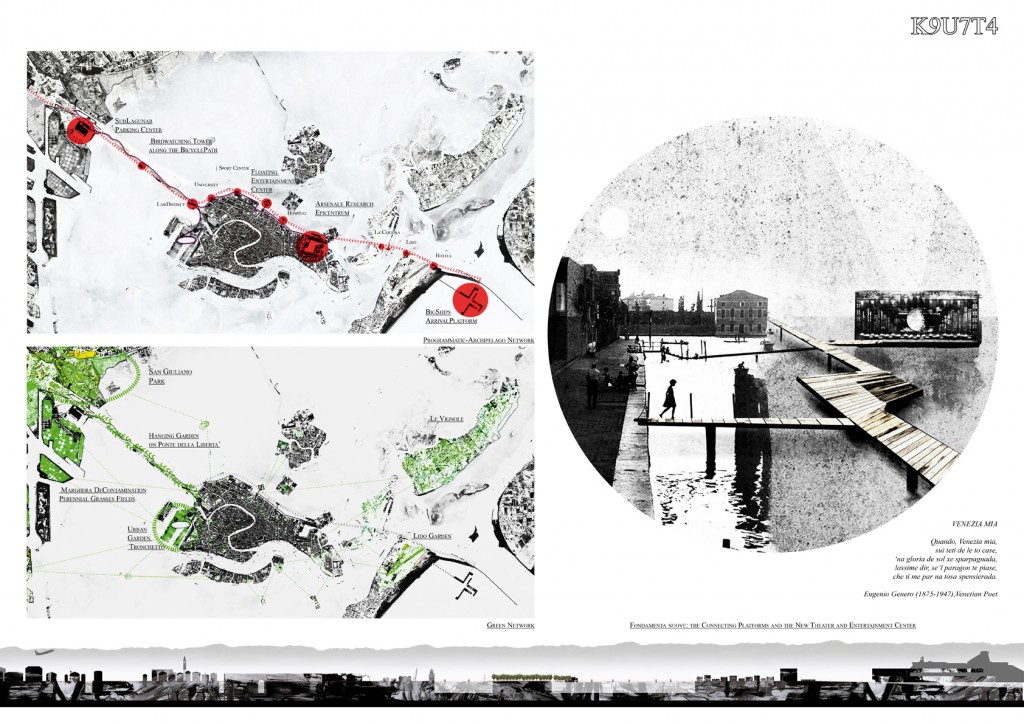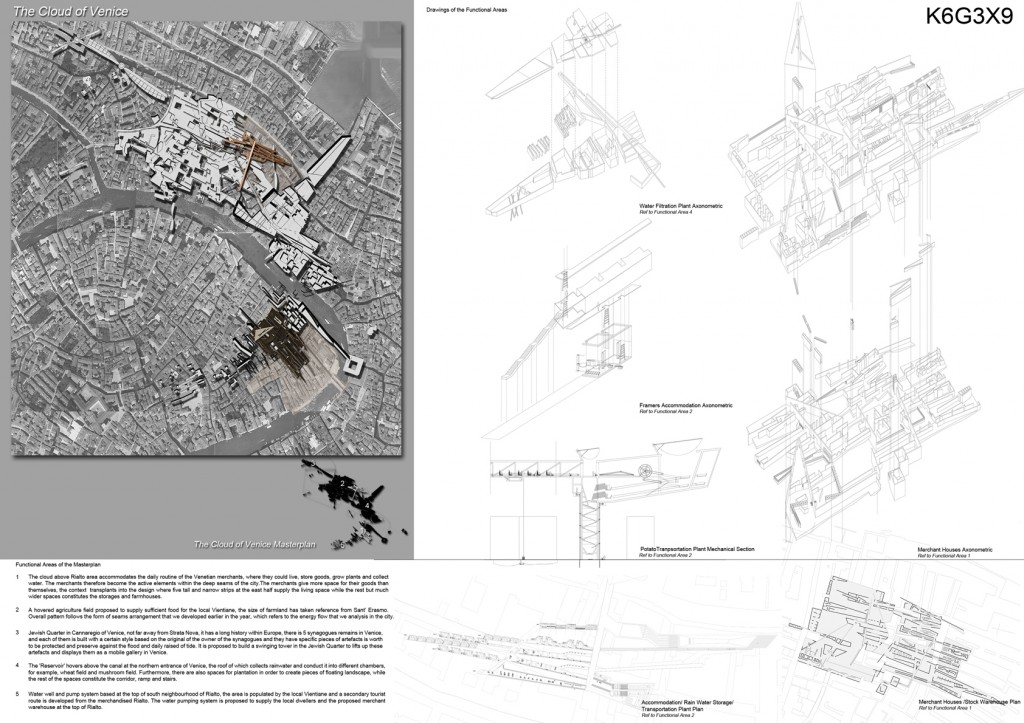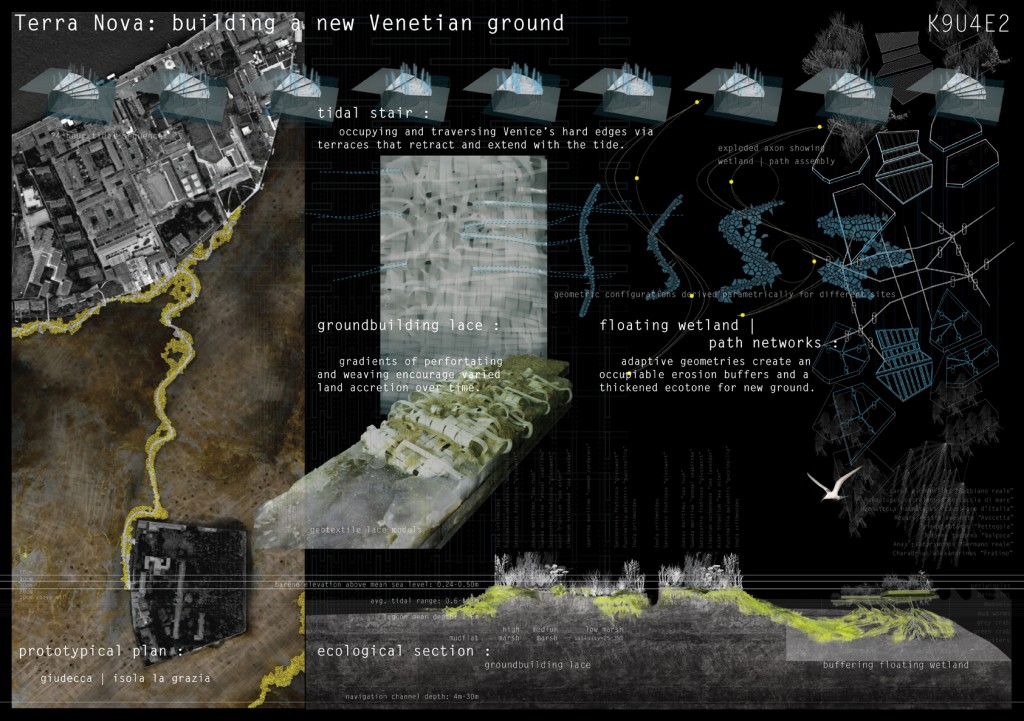Info:
Title: Terra Nova - Code: K9U4E2Contest: Venice / 2011
By: K. Marsh / J. Price / E. Root / J. Sieweke
Views: 6902 Likes: 9
Votes:
BJARKE INGELS5 NERI OXMAN7 ELENA MANFERDINI4 MARIA LUDOVICA TRAMONTIN4 BOSTJAN VUGA44.8
Terra Nova
Terra Nova: building a new Venetian ground Project Statement: Venice symbolizes the strange beauty that is possible when human habitation adapts itself to extreme environmental surroundings. Sea level rise and climate change place the Venetian lagoon at a critical juncture in its existence and necessitate new techniques of adaptation. Terra Nova proposes a new, more flexible set of methods to build ground, improve biodiversity, and permit human access to this critical process in order to allow this very unique city and ecosystem to survive.
Project Narrative: The city of Venice emerged incrementally from its lagoon habitat as the result of technological innovations that allowed people to build solid ground from marshy substrate. The relationship of urban occupation to the ephemeral morphology of the lagoon can be traced through the city’s history as a sequence of adaptations aimed at preserving this unique symbiosis: Starting in the 14th century, siltation from the many rivers that emptied into the lagoon threatened to shift the morphology toward that of a delta, and connect Venice to the mainland. This trend was fought by an impressive campaign of river diversions that spanned into the 17th century. Now, without the rivers adding sediment to the lagoon and with the increasing threat of storm surge and sea level rise, Venice is instead fighting to keep the lagoon from slowly becoming part of the Adriatic.
Campaigns to fight the increasing occurrence of flood, or acqua alta, have focused on centralized interventions – massive flood barriers (the MOSE project) at each of the lagoon’s three mouths to combat the inevitable. This heavy-handed approach is akin to the major river diversions that first reversed the morphological trend, and it fails to recognize the rich Venetian history of dispersed smaller-scale adaptations and management practices that governed the daily existence of Venice and her lagoon: floating mills that could be moved to take advantage of shifting wind and tidal patterns, managing wetlands and salt marshes for continued production of salt and maintaining a diversity of marine and avian species, emerging technologies for supporting and building ground, and complex networks of circulation. This proposal builds on this tradition of understanding and adapting and encourages the reimagining of Venice as a more connective place where social and environmental health are seen as inextricable parts of a comprehensive lagoon ecosystem.
Beginning in the 1980s, it has increasingly been recognized that contemporary development, boat traffic, and fishing had so severely damaged the biodiversity and morphology of the lagoon that deleterious effects were being observed in the structural stability of the city, the cleanliness of the water, and levels of flooding. To repair some of this harm and supplement the storm surge protection of the MOSE, a campaign has been established to restore and construct new salt marshes and mudflats in the most eroded and exposed parts of the lagoon. Current construction practices use sediment dredged from transportation channels to rebuild the salt marshes that have been destroyed due to erosion or inundation. Perimeters of tubular gravel-filled sacks are laid out in forms that attempt to mimic natural morphologies. Dredge material is then pumped in from various places around the lagoon without concern for the particular sedimentary needs of the sites. It is pumped in quickly and without adequate regard for attaining the elevations or soil stratification needed for healthy marsh formations. This practice results in monolithic structures that are often too high to allow for the tidal influences needed to form tidal pools and creeks – that function more like islands than healthy wetlands. The gabion edges of these formations, while effective in preventing erosion control, are too rigid to allow for any topographic variation along the perimeters and restrict the necessary exchanges of sediment and nutrients along the wetland edge.
In addition to these operational issues, there is also exists a physical and intellectual isolation between the people of Venice and ecological processes and issues that surround them. In the past, the city was populated by residents with an inherent connection to the larger lagoon and an understanding of the particular context of this amphibious urbanism. Now, however, the city is filled to capacity with tourists from all over the world who have little exposure to the lagoon or ability to have a positive contribution to its future. If a bodily experience of the lagoon’s ecology is made an integral part of the city of Venice, then perhaps the city can become more ecologically and socially resilient over the long-term through this more true and diverse understanding of the city by both tourists and residents.
Terra Nova addresses these shortcomings through the development of an aquatic geotextile that could be employed throughout the lagoon as part of a new ground-building regime of incremental sediment accretion and supplementation. The geotextile uses patterns of perforations that open and expand like gills to capture and hold sediment. This is applied in layers and pulled and contorted into gradient conditions by a system of flexible woven strips that provides further variations in density and texture along the surface. The layered combination of these two systems creates a surface that gradually thickens and thins in section and opens and closes in plan. This would encourage a slow and varied buildup of ground and the shifting emergence of a diversity of lagoon morphologies and interdependent ecosystems.
These wetland-forming operations would be especially important in areas around the lagoon where ecological health has deteriorated and where heavy boat traffic and tidal influx has led to problems with erosion of lagoon’s floor and its many edges. To protect against this erosion, the gradient between channel and accreting ground would be thickened. The inner edge of the varying geotextile would be porous to allow for a healthy exchange of water and minerals while an outer edge of protection would be created out of a network of floating treatment wetland islands. These islands are made of matrix of recycled plastic curls that supports plant growth and provides habitat for marine invertebrates. The network floats in response to tidal flux and storm surge and provides buffering from harmful boat wakes and waves. The connected network of wetland pads would be anchored in places with a branching web that would thicken the assembly in section to better protect the ground from wave action and aid the dangling roots of the plants in creating habitat for juvenile fish and other lagoon species. In plan the network is a pattern of voronoi pads that is parametrically derived along curve geometries that thicken and thin to create more or less biomass for varying protection and habitat needs.
In places, the voronoi pattern tightens and regularizes along a curve to create a walkway that snakes through the floating network and allows residents and visitors in Venice to occupy this emerging world of ecological activity. The walkway would be accessed through a new typology of stairs that would attach at key places along the hard vertical stone edges of the city and other lagoon islands. These large terracing stairs would retract and extend in the z-axis as an evocative new register of tidal flux that allows for constant access to the water. The new pathway would also open new social spaces for the city: It would provide new publically accessible waterfronts in emerging residential zones and allow pedestrian access to some of the city’s mysterious and beautiful network of peripheral islands that are currently marginalized and underused.
This new multifunctional operation of ground building and floating networks would bring the richness of the lagoon’s ecology into closer proximity with the city of Venice and give it a more evocative and accessible presence within the lagoon. By diversifying and protecting the ecological activity within the lagoon, and allowing people to experience these processes, the project aims to change the perception of Venice from that of a postcard image of narrow alleys and gondola-filled canals to a fantastic city in which the urban fabric, history, and practices are inextricably connected to the processes that constitute this unique lagoon environment.
Related Posts :
Comments:
Info:
Title: Terra Nova
Time: 6 giugno 2011
Category: Venice
Views: 6902 Likes: 9
Tags: Biodiversity , E. Root , Erosion , J. Price , J. Sieweke , K. Marsh , Lagoon , MOSE , MOSE Project , Sediment , Venetian Lagoon , Venice








